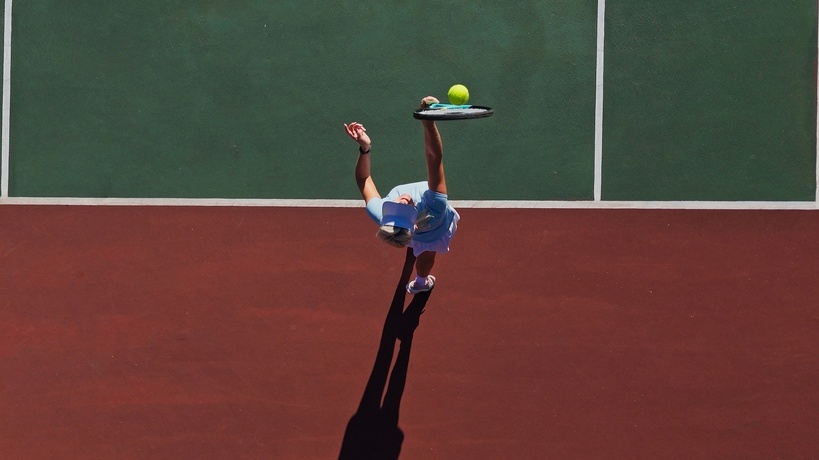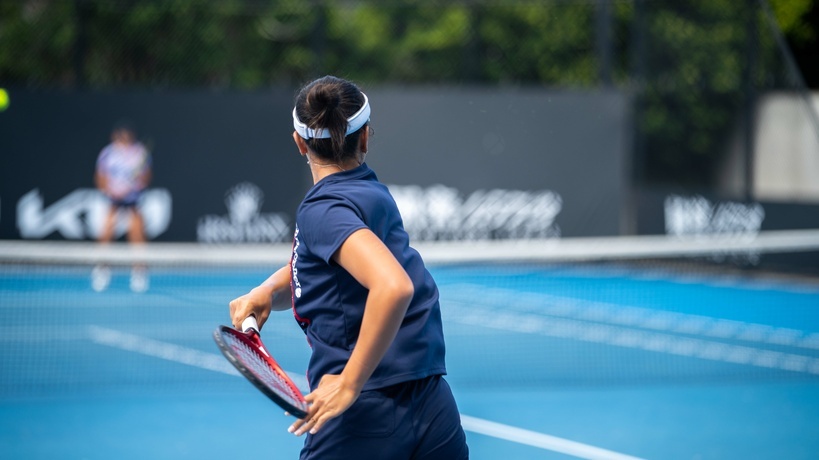Competing successfully on a hard court requires a combination of skill, strategy, and adaptability. With their predictable bounce and medium-fast pace, hard courts reward players who master technique, strategy, and mental focus.
Whether you're a seasoned player or new to the game, understanding the principles of hard-court tennis can help you gain an edge. Below, we’ll cover five essential strategies to win a tennis match on a hard court.
Maintain a Strong Court Position
Your positioning on the court matters as much as your strokes. On a hard court, where the ball travels faster and with consistent bounce, staying in a strong, balanced position is crucial.
Position yourself near the baseline to allow enough time to react to your opponent’s shots. From here, you can move forward for volleys or rallies and backward for deeper shots.
Avoid standing too far behind the baseline, as this gives your opponent control of the game. Instead, dominate the center of the court to remain in an ideal position for groundstrokes.
Keep your feet active to quickly adjust to changing directions—a split step before your opponent’s swing can prepare your body for efficient movement. Also, pay attention to your opponent's tendencies. If they like to hit angled shots, you may need to adjust your court positioning.
Hard courts reward strategic movement and quick reactions, so use your positioning to anticipate your opponent’s plays while dictating your own. When in control of the rally, maintain an offensive court position, pushing your opponent away from the middle and into the sidelines where they’re more likely to commit errors.
Focus on Your Serves and Returns

Serving and returning are pivotal actions in every tennis match, but they’re particularly critical on hard courts. A strong serve can lead to free points, while an effective return can neutralize your opponent’s advantage. Hard courts amplify power, so refining both skills can shift the momentum in your favor.
When serving, concentrate on your placement and variety. A well-placed first serve can force your opponent into defensive positions, giving you the upper hand in the rally.
Alternate between wide and body serves to keep opponents guessing and prevent them from settling into a rhythm. Don’t neglect your spin serves, either. A kick serve or slice serve can prevent your shots from sitting up for easy returns.
On the return side, the goal is to get the ball back into play with enough depth and accuracy to challenge your opponent’s next shot. Keep your racket prepared with a short, compact swing to manage high-speed serves effectively.
A great way to practice your returns is to simulate game scenarios using tennis equipment like ball machines that mimic fast, precise serves. This practice builds muscle memory and boosts your reaction time.
Improve Your Ground Movement
The ability to move efficiently on a hard court is one of the best predictors of success during a match. While hard courts provide a consistent surface for ball movement, the pace can still make tracking shots a challenge. To counter this, work on improving your footwork and ground mobility.
Quick footwork involves taking smaller steps, especially when adjusting to a fast-approaching ball. Sliding, which is common on clay courts, is less feasible on hard courts, meaning precise movement is essential.
Keep your knees bent and your body low as you move; doing so helps with balance and power. Strengthen your core and leg muscles through conditioning drills like ladder runs or short sprints, as they simulate the bursts of energy needed during a match.
Practice lateral movements as well. Many players focus only on running forward or backward but forget that tennis demands side-to-side agility.
Drills such as side shuffles and cross-steps will help you cover the width of the court effectively. Lastly, watch the ball closely off your opponent’s racket. Anticipating where it will land allows you to move quicker and strike in an ideal position.
Hard courts favor players who can stay disciplined in their movements without wasting energy. By focusing on precision and efficiency, you’ll outmaneuver opponents and gain more control during matches.
Shorten the Points
Prolonged rallies on a hard court can lead to fatigue and unforced errors. To conserve energy while putting pressure on your opponent, aim to shorten the points when possible. This tactic requires playing more aggressively and taking advantage of opportunities to end a rally quickly.
One key tactic is to step into your shots and hit with purpose. When you see an open angle, take it, or if your opponent leaves a short ball, approach the net and finish with a volley. Transitioning to offense at the right moments discourages your opponent from settling into long rallies. You don’t have to go for a winner on every point, but you should focus on maintaining an attacking mindset.
Serving and volleying is another effective tactic to shorten points, especially on a hard court where the ball bounces predictably. Serve a deep, fast shot, then position yourself at the net to capitalize on weak returns. If you have solid volleying skills, this approach can become a reliable weapon in your arsenal.
Additionally, keep your opponent guessing by varying your play. Mix in drop shots, wide angles, and approach shots to break their rhythm. Reducing rally length helps you conserve energy while simultaneously placing mental pressure on your opponent to produce consistent and accurate shots.
Accentuate Your Strengths

Every player has unique strengths, and leveraging them is one of the smartest ways to gain an advantage on any court, especially hard courts. Identifying what you do well allows you to dictate the game rather than adapt to your opponent’s strengths.
If you have a powerful forehand, focus on positioning yourself so you can use it more often. Use your backhand primarily to set up offensive forehand plays.
If you’re stronger at the net, look for opportunities to transition forward and end points with volleys. If you enjoy baseline play, aim to win longer rallies by wearing down your opponent with precise and consistent groundstrokes.
Mental and emotional strengths are equally important. Hard courts often amplify fast-paced gameplay, requiring players to stay calm under pressure.
If maintaining composure is a strength of yours, use it to outlast opponents who may falter during crucial points. Develop strategies and routines that help you maintain your focus and manage nerves.
By building on your personal strengths, you can control matches more effectively and play to your natural abilities. Confidence is key, so always bring your best attributes to the forefront of your strategy.
Elevate Your Hard Court Performance
Mastering the game of tennis on hard courts requires a combination of skill, strategy, and preparation. These five strategies to win a tennis match on a hard court will elevate your performance and increase your chances of victory.
Keep striving for improvement and ensure you have the right tools for success. Visit All Star Tennis Courts for tennis court maintenance equipment that will protect your surface and transform your gameplay.

